Ning Xu
Towards Understanding Feature Learning in Parameter Transfer
Sep 26, 2025
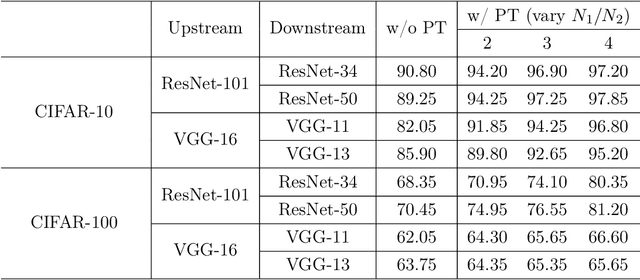

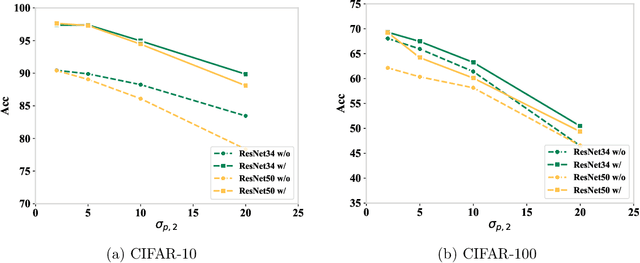
Abstract:Parameter transfer is a central paradigm in transfer learning, enabling knowledge reuse across tasks and domains by sharing model parameters between upstream and downstream models. However, when only a subset of parameters from the upstream model is transferred to the downstream model, there remains a lack of theoretical understanding of the conditions under which such partial parameter reuse is beneficial and of the factors that govern its effectiveness. To address this gap, we analyze a setting in which both the upstream and downstream models are ReLU convolutional neural networks (CNNs). Within this theoretical framework, we characterize how the inherited parameters act as carriers of universal knowledge and identify key factors that amplify their beneficial impact on the target task. Furthermore, our analysis provides insight into why, in certain cases, transferring parameters can lead to lower test accuracy on the target task than training a new model from scratch. Numerical experiments and real-world data experiments are conducted to empirically validate our theoretical findings.
Enriching Knowledge Distillation with Intra-Class Contrastive Learning
Sep 26, 2025Abstract:Since the advent of knowledge distillation, much research has focused on how the soft labels generated by the teacher model can be utilized effectively. Existing studies points out that the implicit knowledge within soft labels originates from the multi-view structure present in the data. Feature variations within samples of the same class allow the student model to generalize better by learning diverse representations. However, in existing distillation methods, teacher models predominantly adhere to ground-truth labels as targets, without considering the diverse representations within the same class. Therefore, we propose incorporating an intra-class contrastive loss during teacher training to enrich the intra-class information contained in soft labels. In practice, we find that intra-class loss causes instability in training and slows convergence. To mitigate these issues, margin loss is integrated into intra-class contrastive learning to improve the training stability and convergence speed. Simultaneously, we theoretically analyze the impact of this loss on the intra-class distances and inter-class distances. It has been proved that the intra-class contrastive loss can enrich the intra-class diversity. Experimental results demonstrate the effectiveness of the proposed method.
HyP-ASO: A Hybrid Policy-based Adaptive Search Optimization Framework for Large-Scale Integer Linear Programs
Sep 19, 2025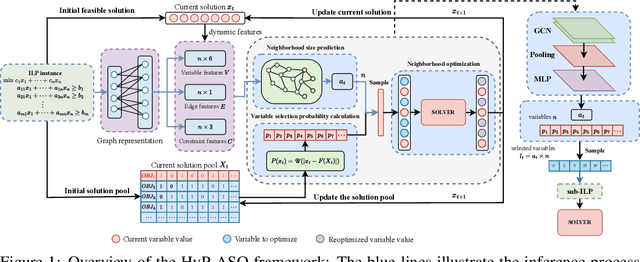

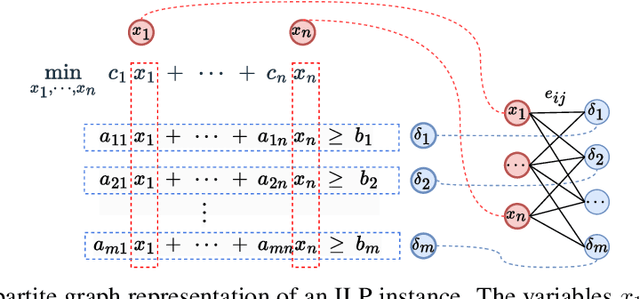

Abstract:Directly solving large-scale Integer Linear Programs (ILPs) using traditional solvers is slow due to their NP-hard nature. While recent frameworks based on Large Neighborhood Search (LNS) can accelerate the solving process, their performance is often constrained by the difficulty in generating sufficiently effective neighborhoods. To address this challenge, we propose HyP-ASO, a hybrid policy-based adaptive search optimization framework that combines a customized formula with deep Reinforcement Learning (RL). The formula leverages feasible solutions to calculate the selection probabilities for each variable in the neighborhood generation process, and the RL policy network predicts the neighborhood size. Extensive experiments demonstrate that HyP-ASO significantly outperforms existing LNS-based approaches for large-scale ILPs. Additional experiments show it is lightweight and highly scalable, making it well-suited for solving large-scale ILPs.
Nemotron-H: A Family of Accurate and Efficient Hybrid Mamba-Transformer Models
Apr 10, 2025

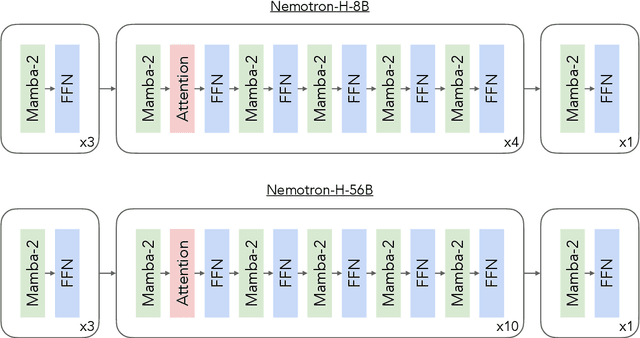
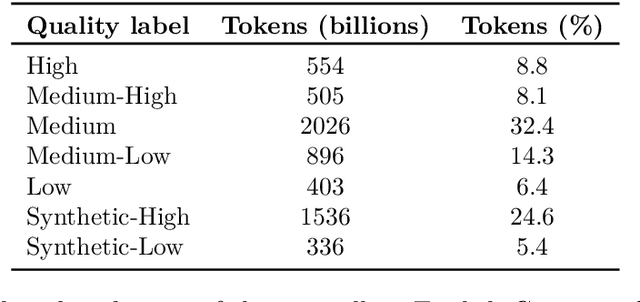
Abstract:As inference-time scaling becomes critical for enhanced reasoning capabilities, it is increasingly becoming important to build models that are efficient to infer. We introduce Nemotron-H, a family of 8B and 56B/47B hybrid Mamba-Transformer models designed to reduce inference cost for a given accuracy level. To achieve this goal, we replace the majority of self-attention layers in the common Transformer model architecture with Mamba layers that perform constant computation and require constant memory per generated token. We show that Nemotron-H models offer either better or on-par accuracy compared to other similarly-sized state-of-the-art open-sourced Transformer models (e.g., Qwen-2.5-7B/72B and Llama-3.1-8B/70B), while being up to 3$\times$ faster at inference. To further increase inference speed and reduce the memory required at inference time, we created Nemotron-H-47B-Base from the 56B model using a new compression via pruning and distillation technique called MiniPuzzle. Nemotron-H-47B-Base achieves similar accuracy to the 56B model, but is 20% faster to infer. In addition, we introduce an FP8-based training recipe and show that it can achieve on par results with BF16-based training. This recipe is used to train the 56B model. All Nemotron-H models will be released, with support in Hugging Face, NeMo, and Megatron-LM.
CSF: Fixed-outline Floorplanning Based on the Conjugate Subgradient Algorithm Assisted by Q-Learning
Apr 04, 2025Abstract:To perform the fixed-outline floorplanning problem efficiently, we propose to solve the original nonsmooth analytic optimization model via the conjugate subgradient algorithm (CSA), which is further accelerated by adaptively regulating the step size with the assistance of Q-learning. The objective for global floorplanning is a weighted sum of the half-perimeter wirelength, the overlapping area and the out-of-bound width, and the legalization is implemented by optimizing the weighted sum of the overlapping area and the out-of-bound width. Meanwhile, we also propose two improved variants for the legalizaiton algorithm based on constraint graphs (CGs). Experimental results demonstrate that the CSA assisted by Q-learning (CSAQ) can address both global floorplanning and legalization efficiently, and the two stages jointly contribute to competitive results on the optimization of wirelength. Meanwhile, the improved CG-based legalization methods also outperforms the original one in terms of runtime and success rate.
GaussianCAD: Robust Self-Supervised CAD Reconstruction from Three Orthographic Views Using 3D Gaussian Splatting
Mar 07, 2025



Abstract:The automatic reconstruction of 3D computer-aided design (CAD) models from CAD sketches has recently gained significant attention in the computer vision community. Most existing methods, however, rely on vector CAD sketches and 3D ground truth for supervision, which are often difficult to be obtained in industrial applications and are sensitive to noise inputs. We propose viewing CAD reconstruction as a specific instance of sparse-view 3D reconstruction to overcome these limitations. While this reformulation offers a promising perspective, existing 3D reconstruction methods typically require natural images and corresponding camera poses as inputs, which introduces two major significant challenges: (1) modality discrepancy between CAD sketches and natural images, and (2) difficulty of accurate camera pose estimation for CAD sketches. To solve these issues, we first transform the CAD sketches into representations resembling natural images and extract corresponding masks. Next, we manually calculate the camera poses for the orthographic views to ensure accurate alignment within the 3D coordinate system. Finally, we employ a customized sparse-view 3D reconstruction method to achieve high-quality reconstructions from aligned orthographic views. By leveraging raster CAD sketches for self-supervision, our approach eliminates the reliance on vector CAD sketches and 3D ground truth. Experiments on the Sub-Fusion360 dataset demonstrate that our proposed method significantly outperforms previous approaches in CAD reconstruction performance and exhibits strong robustness to noisy inputs.
Reduction-based Pseudo-label Generation for Instance-dependent Partial Label Learning
Oct 28, 2024



Abstract:Instance-dependent Partial Label Learning (ID-PLL) aims to learn a multi-class predictive model given training instances annotated with candidate labels related to features, among which correct labels are hidden fixed but unknown. The previous works involve leveraging the identification capability of the training model itself to iteratively refine supervision information. However, these methods overlook a critical aspect of ID-PLL: the training model is prone to overfitting on incorrect candidate labels, thereby providing poor supervision information and creating a bottleneck in training. In this paper, we propose to leverage reduction-based pseudo-labels to alleviate the influence of incorrect candidate labels and train our predictive model to overcome this bottleneck. Specifically, reduction-based pseudo-labels are generated by performing weighted aggregation on the outputs of a multi-branch auxiliary model, with each branch trained in a label subspace that excludes certain labels. This approach ensures that each branch explicitly avoids the disturbance of the excluded labels, allowing the pseudo-labels provided for instances troubled by these excluded labels to benefit from the unaffected branches. Theoretically, we demonstrate that reduction-based pseudo-labels exhibit greater consistency with the Bayes optimal classifier compared to pseudo-labels directly generated from the predictive model.
LSVOS Challenge Report: Large-scale Complex and Long Video Object Segmentation
Sep 09, 2024



Abstract:Despite the promising performance of current video segmentation models on existing benchmarks, these models still struggle with complex scenes. In this paper, we introduce the 6th Large-scale Video Object Segmentation (LSVOS) challenge in conjunction with ECCV 2024 workshop. This year's challenge includes two tasks: Video Object Segmentation (VOS) and Referring Video Object Segmentation (RVOS). In this year, we replace the classic YouTube-VOS and YouTube-RVOS benchmark with latest datasets MOSE, LVOS, and MeViS to assess VOS under more challenging complex environments. This year's challenge attracted 129 registered teams from more than 20 institutes across over 8 countries. This report include the challenge and dataset introduction, and the methods used by top 7 teams in two tracks. More details can be found in our homepage https://lsvos.github.io/.
Progressively Selective Label Enhancement for Language Model Alignment
Aug 05, 2024Abstract:Large Language Models have demonstrated impressive capabilities in various language tasks but may produce content that misaligns with human expectations, raising ethical and legal concerns. Therefore, it is important to explore the limitations and implement restrictions on the models to ensure safety and compliance, with Reinforcement Learning from Human Feedback (RLHF) being the primary method. Due to challenges in stability and scalability with the RLHF stages, researchers are exploring alternative methods to achieve effects comparable to those of RLHF. However, these methods often depend on large high-quality datasets and inefficiently utilize generated data. To deal with this problem, we propose PSLE, i.e., Progressively Selective Label Enhancement for Language Model Alignment, a framework that fully utilizes all generated data by guiding the model with principles to align outputs with human expectations. Using a dynamically updated threshold, our approach ensures efficient data utilization by incorporating all generated responses and weighting them based on their corresponding reward scores. Experimental results on multiple datasets demonstrate the effectiveness of PSLE compared to existing language model alignment methods.
ChipExpert: The Open-Source Integrated-Circuit-Design-Specific Large Language Model
Jul 26, 2024Abstract:The field of integrated circuit (IC) design is highly specialized, presenting significant barriers to entry and research and development challenges. Although large language models (LLMs) have achieved remarkable success in various domains, existing LLMs often fail to meet the specific needs of students, engineers, and researchers. Consequently, the potential of LLMs in the IC design domain remains largely unexplored. To address these issues, we introduce ChipExpert, the first open-source, instructional LLM specifically tailored for the IC design field. ChipExpert is trained on one of the current best open-source base model (Llama-3 8B). The entire training process encompasses several key stages, including data preparation, continue pre-training, instruction-guided supervised fine-tuning, preference alignment, and evaluation. In the data preparation stage, we construct multiple high-quality custom datasets through manual selection and data synthesis techniques. In the subsequent two stages, ChipExpert acquires a vast amount of IC design knowledge and learns how to respond to user queries professionally. ChipExpert also undergoes an alignment phase, using Direct Preference Optimization, to achieve a high standard of ethical performance. Finally, to mitigate the hallucinations of ChipExpert, we have developed a Retrieval-Augmented Generation (RAG) system, based on the IC design knowledge base. We also released the first IC design benchmark ChipICD-Bench, to evaluate the capabilities of LLMs across multiple IC design sub-domains. Through comprehensive experiments conducted on this benchmark, ChipExpert demonstrated a high level of expertise in IC design knowledge Question-and-Answer tasks.
 Add to Chrome
Add to Chrome Add to Firefox
Add to Firefox Add to Edge
Add to Edge